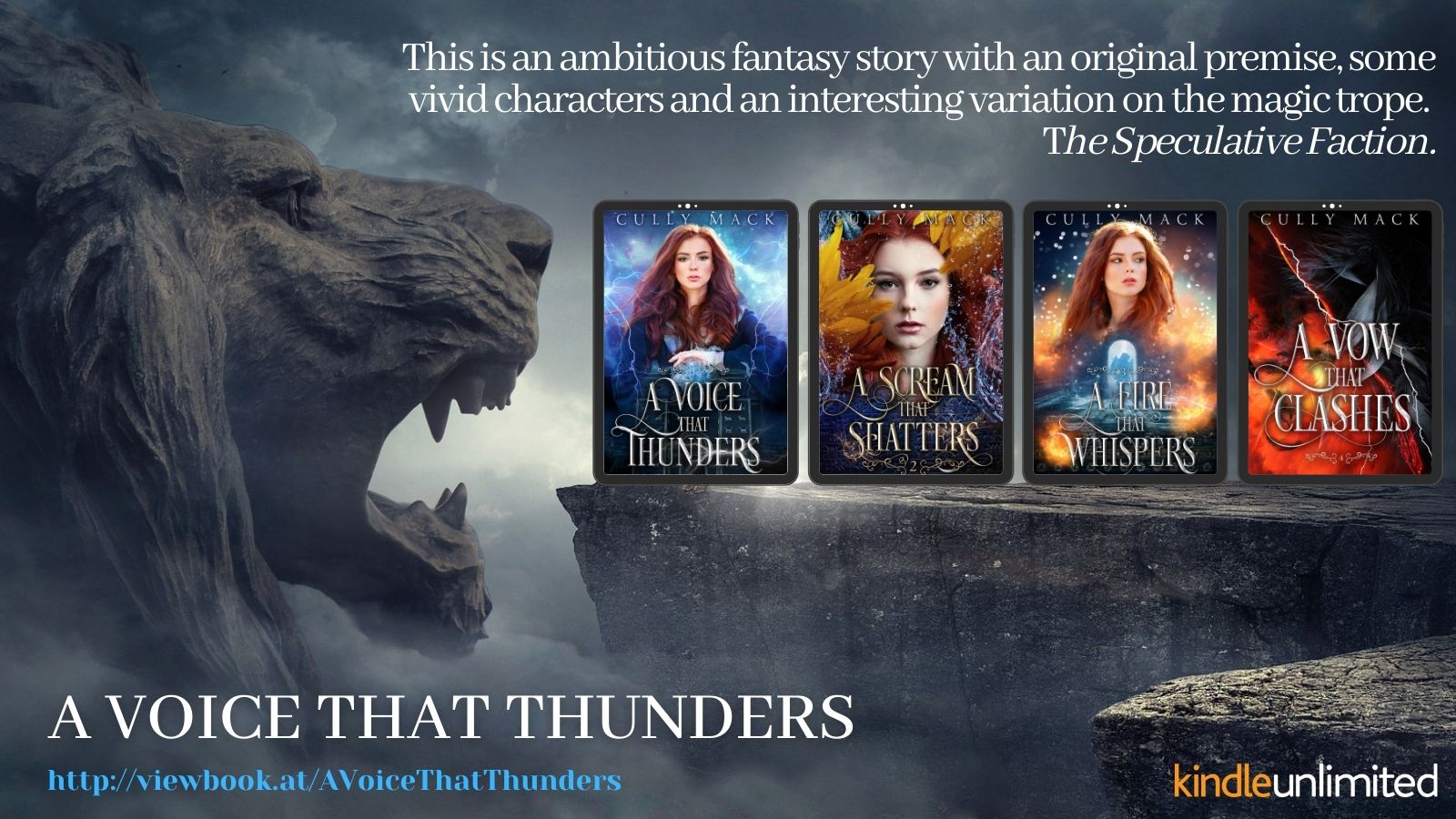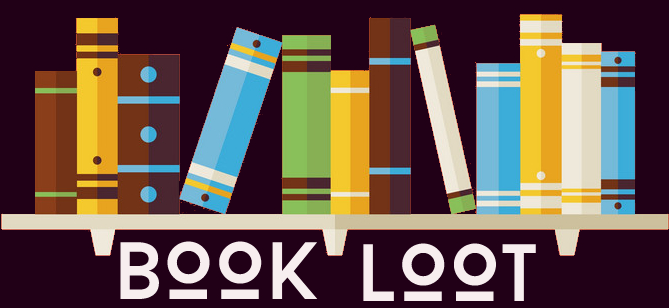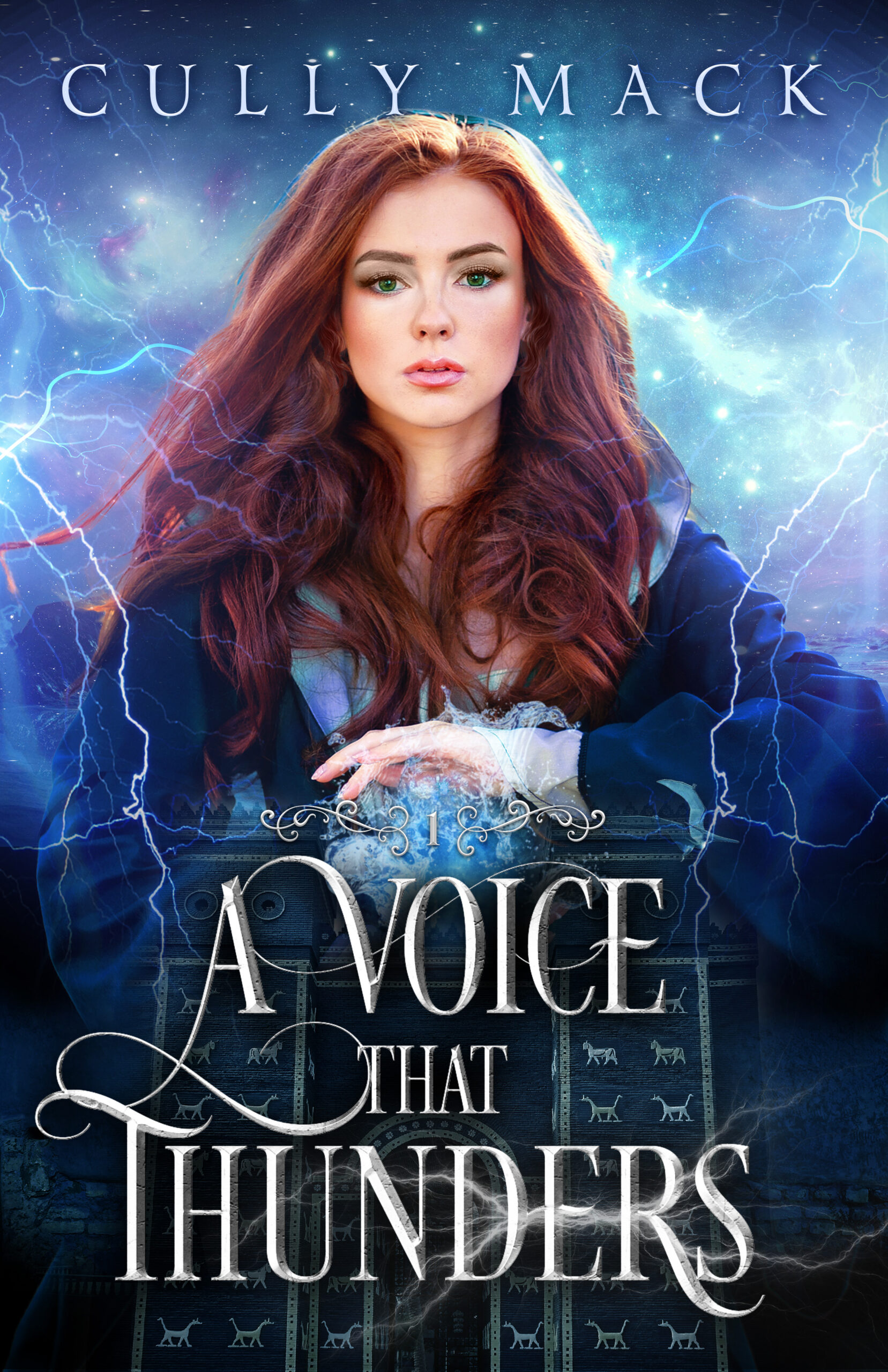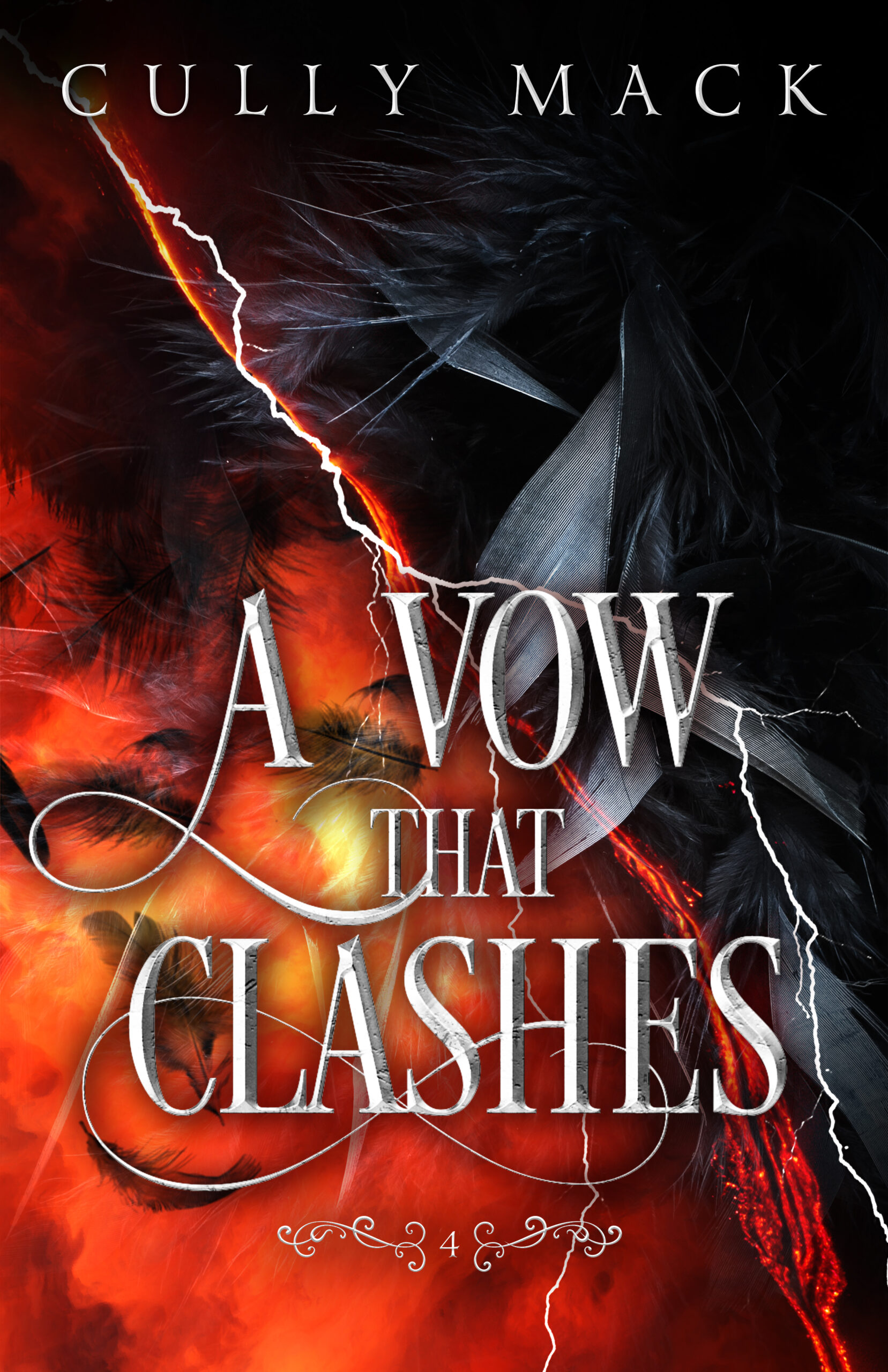Interview with Cully Mack – Author of A Voice That Thunders
Lloyd Alexander once said, “Fantasy is hardly an escape from reality. It’s a way of understanding it.” Book Loot believes in every single word in that quote. Fantasy is more than just concepts and ideas. It’s a living spirit that pulls us to the horizon and beyond, a door that opens to an infinite number of worlds.
Today, Book Loot is excited to talk to an author who continues to feed the universe of fantasy with epic worlds and fantastic characters that you will never have enough of. Her series A Voice That Thunders is a testament to her craft.
Cully Mack is the creator of a world filled with giants and mythical creatures, and we are excited for the chance to ask her our own questions.
Our Interview with Cully Mack
-
-
- Before we begin, would you please tell our readers a little about yourself?
Hi! My name is Cully, and I’m the author of the Voice that Thunders, an epic fantasy series themed on Mesopotamian mythology. I live in England where it doesn’t always rain, I promise.When I’m not writing, I’m either reading or seeking new adventures. I love exploring old things and discovering the world of our ancient past, whether that’s the historical or the mythological.
I’m a dog lover, tea drinker, and hoarder of books.
- What inspired you to start writing fantasy?
I have always been an avid reader of fantasy, but I began writing by accident. My mother retired and enrolled on an introductory creative writing course. I decided to join her. Up until that point, I had this notion that writing was for the ‘professionals’, whatever that meant.Regardless, I loved the writing experience! I’ve always had a creative streak, dabbling in various arts and photography. But writing, it’s like creating something which never existed until you put the words on the page. It’s like nothing else… characters, worlds, conflict. They all came alive in my head. In that short course I created a character called Ammo. He’s a man for hire, an Acquisitioner who gets the jobs done. The cocky rogue never left my head, and he unsurprisingly turned up in my books.
After the course, I quit my job and returned to university to study English Literature and Creative Writing because, as I said, I had this silly notion of professionalism. I enjoyed my time there, and learned an awful lot, but studying the way I did isn’t essential. What is essential is following your passion and your dreams. Mine just happened to be writing, fantasy, and mythology.
Alongside fantasy, I’ve always been interested in mythological texts from Ancient Mesopotamia.
As you mentioned in your opening quote, “Fantasy is hardly an escape from reality. It’s a way of understanding it.” Myth is the same. In fact, I’d go so far as to say myth is the fantasy genre’s predecessor. Myth is a symbolic narrative framing universal questions, which mankind has been asking since… well, forever. Why are we here? What are our origins? Is there a god or gods? How do we make sense of life, death, good, evil, truth, falsehood.? Etc, etc. What the fantasy genre often does is delve into myth. Fantasy readers will already have come across Egyptian, Norse, Arthurian, and Fae to name a few. By creating new stories, fantasy aids us in making sense of what is happening in the world and human experience relevant to our time.
Brian Attebery explains it this way:
“By telling stories about, around, and upon mythic stories, we put ourselves onto the same stage with the gods and heroes and monsters, and thus are forced to confront our godlike, heroic, monstrous selves.”
Mesopotamia was the birthplace of civilization. It’s where our mythic stories began. If myth is a retelling of a retelling, I wanted to start at the beginning. Many peoples lived side by side, sometimes in unity but more often they were warring. In my series, I’ve tried to capture an essence of their cultures, what it was like thousands of years ago, and set it in a framework loosely based on some of their customs and beliefs. My series is filled with ancient myth, the kind that is buried in soul waiting to be reawakened.
- What is the most surprising thing you discovered while writing your books?
To trust my instincts. I’m a discovery writer. When I began writing my first book, I had no idea how it might end. I didn’t even know what characters would turn up on the page. Now this isn’t to say I didn’t know about writing, because I did. I’d been studying writing craft for years by this point. I knew how to structure a story; I just didn’t have the story plotted or figured out in my head.
What I did have was a conflict—immortals conquering the realm with their armies of gigantic sons and chimeric beasts, and a character who would somehow bring about their downfall. This was my start point. The whole world, characters and everything else expanded from there.
One of the most fascinating things I’ve discovered is the ability to test my characters. It kind of came from giving my characters internal and external conflicts. I’d have this great idea and run with it and through the writing process discover how they would overcome (or in some cases fail) the challenges they faced.
Over time, it’s kind of evolved into trying to discern how much my characters can take before they break. Two characters, in particular, Ammo, who was the character I created on my original writing course, and Tur, who appears in book two, are constantly challenging me. Every time I up the stakes, they find ways to outwit me! I think this is the beauty of discovery writing. Writing characters who can set their own limits and dictate how their story unfolds.
In all honesty, five books later, I still don’t know how my series will end. Or who will survive!
- It is universally known that every writer is also a reader, yet each is different from the other. What do you think distinguishes writing for reading, and vice versa?
I split my reading for writing into various topics. These are generally broken into two groups. What I would call academic research and creative research. I use academic research for world-building, e.g. culture and customs, flora and fauna, mythology, and an endless list of other topics, from medicine to war tactics and so on. It’s important for me to create a fully realized secondary world. My aim is to transfer the reader’s mind via vivid imagery to a world unlike our own. Gods, magic, mythical beings are all awesome, but they need a concrete setting.For me, creative research is more about character development, narrative techniques, themes, etc. I’m always reading fiction and will pause to study the works of authors who excel in certain areas. I love it when I find an author who uses language in unique ways or has a gift with creating exceptional characters or manages to write a plot twist I didn’t see coming. If I find myself asking, how did you do that, that is when I’m interested in learning from their techniques.
Writing for reading is another approach entirely. Firstly, I am writing for mature YA to adult audiences who love epic fantasy, so I’m keen to stay within the parameters of their genre expectations.
I enjoy the writing process, but I’m very conscious that the final product is for the reader. I’m a firm believer in without conflict you have no story. So, I’m always analyzing my writing, evaluating potential reader responses, seeing how far I can push things. This is not to say I avoid challenging subjects, because I don’t.
- Could you please tell us a little about Voice That Thunders?
Voice That Thunders is an epic fantasy series which features siblings, Mirah and Gabe, who become central characters along with a band of rebels fighting against immortals conquering their realm. It’s a pre-civilised world influenced by Mesopotamian mythology. Think epic battles with immortals and beasts of all kinds, throw in elemental magic, huge plot twists, portals and unique worlds, and an ever-growing number of characters trying to save their world. If you love character-driven fantasy, you’ll love my books. I warn you now; I don’t go easy on them.I’m not afraid to write what the story needs. In places, it’s dark (but not grimdark). People die! The battles are intense, blending weapons, magic and intelligence. No one is safe! I’ve got messages from fans to prove it. I always tell them the same, trust me, keep reading. The monsters are unique. Ever heard of Dactyrs or Dagani? The cast is huge, with two or three plot arcs often running parallel, and narrated from multiple pov’s.
I’m a discovery writer, so the plot twists in unexpected ways. You’ll find romance and broken hearts (sorry). Even so, romance isn’t the main plot. I’ve been told many times that my writing is very visual and how reading my books is like watching a movie. I’ll let you be the judge of that…
- Currently the series contains four books and a prequel, how many books will be there? And when will the next one become available?
The prequel called Sojin features two side characters, Ammo and Sojin, who become central to the plot as the story unfolds. I plan to do a spin-off series with Sojin and members of the Grey Wolf tribe who appear in book four.I am currently writing the 5th book and I hope to have it published by the end of the year. Will it be the end? I’m not sure! I’m hoping so, but I can’t guarantee I’ll have all the threads completed in this book. There is a lot happening, characters are on opposite sides of the world, there are still many foes to defeat. Readers already say I keep them up all night and/or on the edge of their seat, If I can complete everything in book five, it’s going to be an epic ending.
- Your covers are among the most beautiful we have seen, was there a special inspiration behind them?
Wow! That’s lovely of you to say. To be honest, I had no idea what I was doing. All praise goes to Maria Spada for designing them.The first hurdle to overcome was the series having two sibling protagonists, and we didn’t want to give the impression of them being a romantic couple. Hence only Mirah is on the cover of the first three books.
It was important for me to have Mesopotamian representation because it’s a huge theme in the books. You’ll see on A Voice That Thunders, the reconstruction of the Ishtar Gate with the dragon, lion, and bull iconography. A Scream That Shatters has cuneiform script, and A Fire That Whispers has part of the reconstructed wall from Nebuchadnezzar’s throne room on the lower half of the cover.
The fourth book, A Vow That Clashes is very different because it focuses on other characters, namely Sojin, Neviah and Gabe. The raven feathers, fire, and lightning are representations of those characters and their special abilities.
The series has elemental magic, and these elements are also incorporated into the covers with lightning, water and fire. I’m sure other elements will appear in future books.
- Finally, if any of our readers want to interact with you, where can they find you?
- What inspired you to start writing fantasy?
- Before we begin, would you please tell our readers a little about yourself?
-
We would like to thank you very much for answering our questions and can’t wait to read more of your stories.
Click here to purchase A Voice That Thunders (Available at 0.99$ until the 22nd of June)

Cully Mack received her BA in English Literature and Creative Writing and her MA in Creative Writing at Plymouth University.
She resides in England with Leo her loyal four-legged companion who knows more about Gabe, Mirah, (and the rest of the characters mingling in Cully’s head) than any dog should.
For Cully’s updates check out her Facebook page:
https://www.facebook.com/CullyMack/
Or Facebook Group for the Voice that Thunders Series
https://www.facebook.com/groups/2308034742648180/




